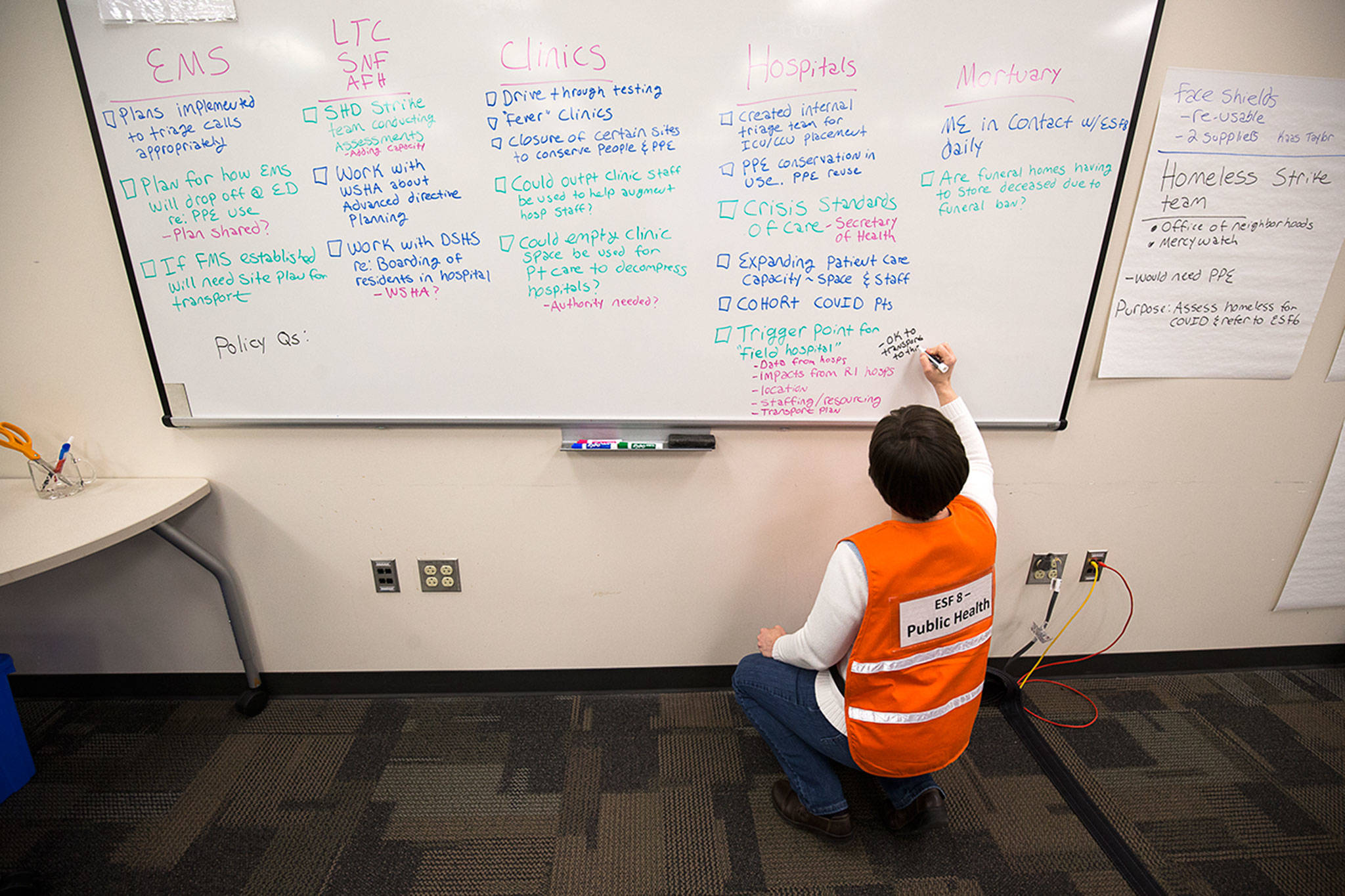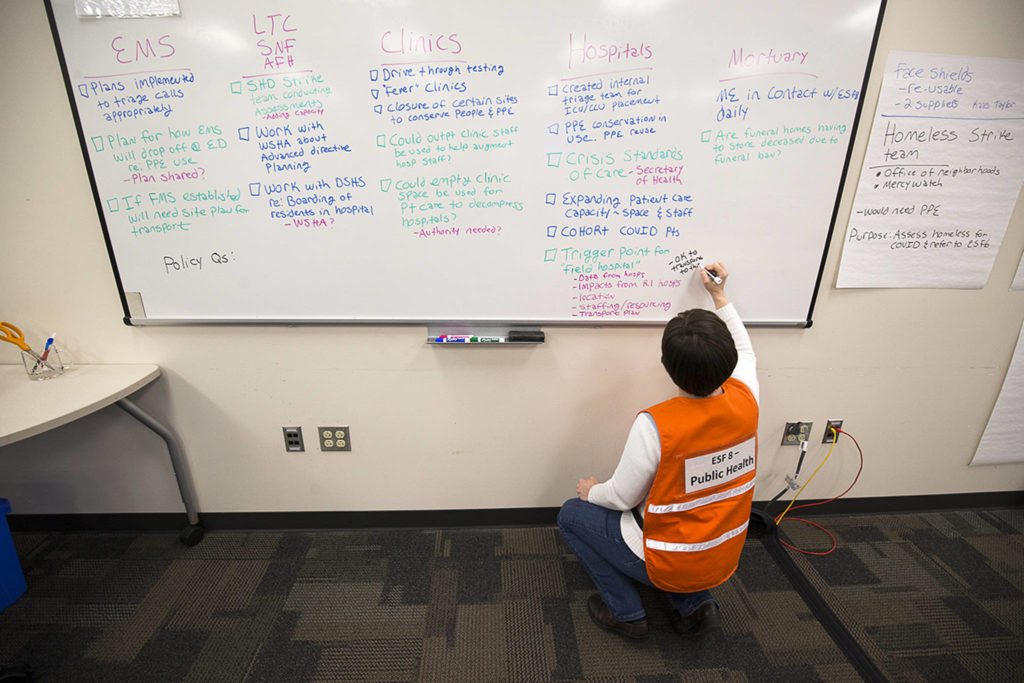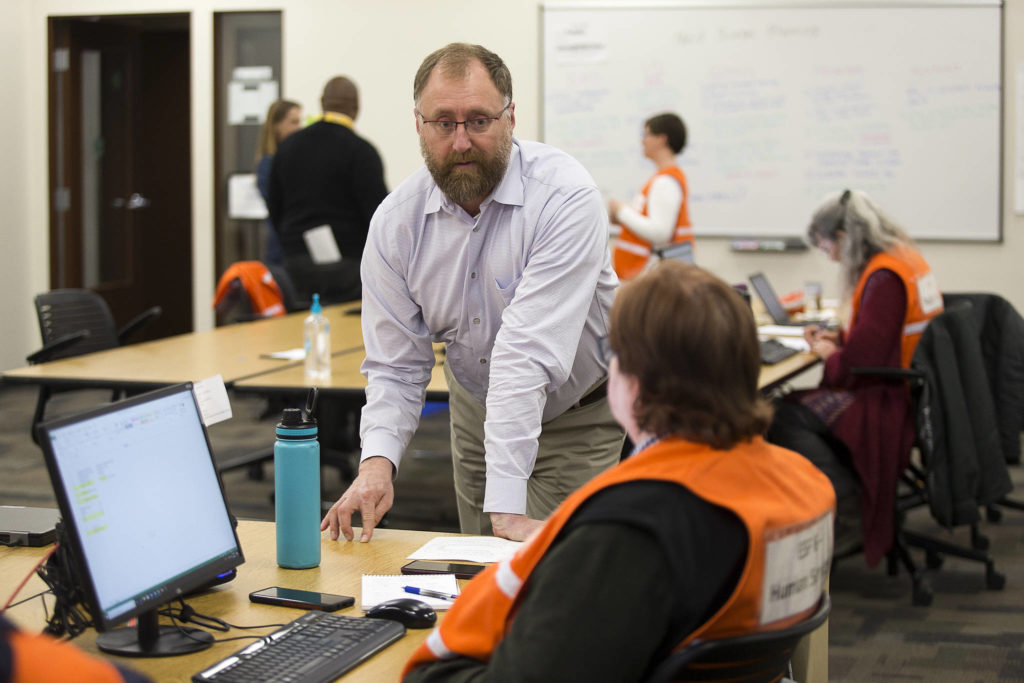EVERETT — For years, crisis managers rehearsed their response to a worst-case scenario: a devastating earthquake with hundreds of deaths in Snohomish County.
A mock quake could not prepare them for many of the challenges of COVID-19.
“As incredibly catastrophic as an earthquake would be, it wouldn’t be the whole nation,” Snohomish County Department of Emergency Management director Jason Biermann said. “So in terms of sharing resources, some of the tools we had in place to help us in an earthquake, like folks coming in from another state to help us, that’s not available.”
Unlike the sudden damage a quake would cause, COVID-19 has ramped up over weeks, unpredictably and mercilessly.
Snohomish Health District administrative officer Shawn Frederick remembers the exact moment he realized the outbreak could become dire.
“It was February 28,” he said without pausing.
It was a Friday. Frederick was at a retreat when he got word of the county’s second COVID-19 case, and then a third.
By March 1, a crisis response center sprung to life at an unassuming office off Boeing Freeway. Now it is the nerve center for Snohomish County’s offensive against the virus. Each day, around 7 a.m., 30 to 40 people file into a massive, wide-open room, signing in as they pass a folding table.
Based on their job, they grab one of many colored vests off of a rack: red, yellow, blue, orange, purple or tan.
Since the Snohomish County Department of Emergency Management moved to this building in 2012, Biermann said the center has been activated 15 to 20 times, once or twice a year, usually for flooding or wind storms.
The center takes all the essential personnel for handling a major crisis and puts them in one room: police brass, fire chiefs, health experts, policy analysts and so on.
“They’re here to problem-solve,” Biermann said.
On Monday, many of the veteran leaders in the center drew parallels to another time they spent weeks within those same walls — the Oso mudslide in 2014, when 100 people manned the center for 40 days.
For COVID-19, the center had been open for 35 days as of Sunday.
“We’re working Oso hours,” said Scott North, wearing a blue vest with his acting role on the back, “Joint Information Center Director.”
North, a longtime reporter for The Daily Herald, has been pulled from his day job as a county Department of Emergency Management spokesperson to work full-time, and then some, in the Emergency Coordination Center.
A few weeks ago, the office was a dark, echoey room with some scattered desks and blank TV monitors.
Screens now broadcast Johns Hopkins University’s real-time confirmed COVID cases map alongside the county’s local version.
Teams settle into desks in groups. Experts in health, housing, social services and other fields sit in the middle, brainstorming like an emergency think tank.
One of the experts is Alessandra Durham, senior analyst for the county executive’s office, working on homelessness and social justice policies. Three weeks ago, she and a team of two others were given their task: create a 150-bed quarantine center with medical services from scratch.
It would be a site where people without housing, or those with a vulnerable family member in their home, could shelter in place.
“It’s like trying to magic up a solution for the homelessness problem,” North said, “and then throw in COVID.”
It took 2½ weeks to work through big-picture questions:
How do we keep people separated?
Which doctor will oversee medical operations?
How will people pass the time?
What will happen to people’s pets while they’re at the quarantine site?
After leaving behind a trail of bullet-point lists, hastily scratched notes and crossed-out ideas on whiteboards, by Monday, they’d moved on to the details, like writing job descriptions for the people who would work at the site.
On the surface, the coordination center doesn’t look too different from the average office.
Faces are lit by the glow of screens, eyes fixed, while fingers type away. There’s a baseline hum of voices on the phone. On communal tables are essential snacks: a basket full of chocolates, a Costco-sized bag of Sour Patch Kids, a half-eaten muffin sitting forlorn beside a keyboard.
A few things set this apart from previous activations. Each chair is about 6 feet apart. Jumbo hand sanitizer containers are dispersed throughout the room.
Most days, the center runs at a steady churn.
Then there are the frantic days, like when the governor ordered every school in the county to shut down.
In an earthquake, the department could make defined objectives: clear 10 buildings, search 100 square miles.
“But this — there’s a level of uncertainty that makes communicating to the public, or even our first responders, hard,” Biermann said.
The department could not predict the spread of COVID-19, so they could not practice exactly what the response would be. But Biermann said they’d already established the backbone of a crisis management system.
“We saw this during Oso, too,” said Stephanie Wright, a Snohomish County councilmember and Snohomish Health District board chair. “You run scenarios, but nothing is a perfect scenario. But it was the relationships and the structure that got us through that.”
The center stays open as long as it takes to accomplish five main priorities:
• Protect the most at-risk populations from COVID-19, including the unsheltered and elderly.
• Address impacts of school closures.
• Set up an isolation and quarantine site. This happened Wednesday.
• Mitigate the surge of medical needs.
• Temper the economic impacts on local businesses.
As those needs are met, the number of people in the center will dial back. But they could ramp back up if new needs arise, North said.
In terms of controlling the spread of COVID-19, Snohomish County is running out of options.
Outside of having a vaccine, leadership has a list of non-pharmaceutical interventions to stem the disease’s spread.
There are 13 steps.
We’re on step 12.
“The next one would be completely isolating an area, like they did in China,” Biermann said.
Research shows that sort of drastic action, known as cordon sanitaire, doesn’t help much unless it’s limited to a small area, Biermann said. That may not be realistic in our region.
“Theoretically, could we do more? Yeah. Would it be worth it? Probably not,” Biermann said. “Because there’s a tradeoff with that sort of really strict isolation. Folks may not be able to access food, and there’s the mental and psychological impacts of feeling like you’re truly isolated.”
It would likely take direction from the governor to make that move. In the past four weeks, policies have changed at breakneck speed.
But Biermann said county leadership’s decisions aren’t reactive, they’re calculated.
“All this planning is happening behind the scenes,” he said. “We have folks looking ahead, in some cases, weeks. Not because we are necessarily certain, but because there are a lots of contingency plans. There are a lot of deliberate and informed decisions.”
Those inside the emergency coordination center are living their own story of the pandemic, with their own families and their own fears.
That’s part of what makes them such a formidable team, North said.
“If you look around in that room, this is an emergency that’s reaching every corner of our community, and you’ve got people from every corner of our community in here working, bringing what they know, bringing their skills and their passion,” North said. “That’s what the virus is up against.”
Julia-Grace Sanders: 425-339-3439; jgsanders@heraldnet.com.
Talk to us
> Give us your news tips.
> Send us a letter to the editor.
> More Herald contact information.





























